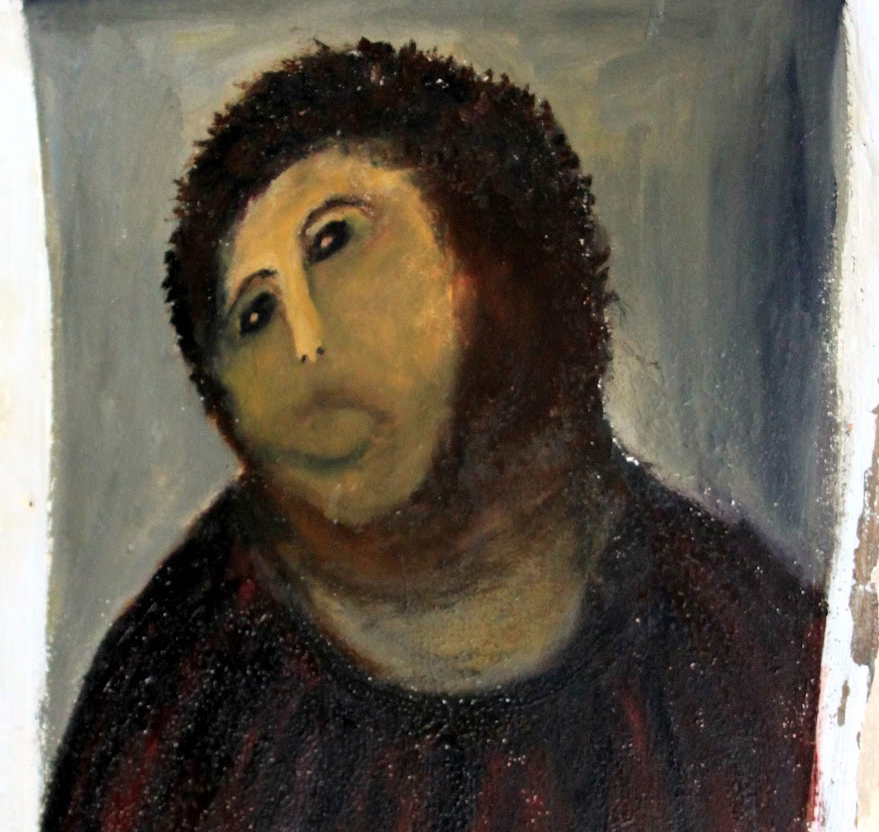On artistic supercession
On Tuesday, July 28, I gave a lecture on Aesthetics and Cultural Bias to a Cultural Anthropology class being taught by a friend of mine at the local community college. I decided against publishing the full lecture, as it is kind of an amateurish work on the whole. To give a synopsis: it calls out cultural pre-conceptions about art as having a white male bias, discusses aesthetics from a perspective hostile to dualism (Kant / Hegel), criticizes Capitalism as a dominant force in culture, discusses objecthood and fuzziness in terms of framing & the White Cube, discusses aesthetic arrest & the illusion of separation… all in the course of an hour. Yeesh. TOO MANIC. You shouldn’t wonder why I don’t want to share it.
–
At any rate, I finished the talk with a discussion of the Restoration of Ecce Homo by Cecilia Gimenez. In case you don’t recall, it looks a little something like this:

–
–
The talk pointed out the ethnocentrism inherent in the wide, public response to the work, seen in news reports and funny internet memes. One of the questions in the discussion led to some further thoughts, which I do think might be worth consideration (maybe because this is less scatterbrained than the whole lecture??)
–
This was sent as an email to the professors in charge of this class on the evening of July 30.
–
–
I’ve had some further thoughts on the discussion in class that followed my lecture on aesthetics and cultural bias. I was impressed that the discussion brought out a good deal of the complexity of the issues surrounding the restoration of Ecce Homo by Cecilia Gimenez. My prepared remarks covered primarily the implications of the judgments of whether the piece was “good” (a moral judgment) or not from a standpoint of whether or not it met cultural ideals of beauty, and also the fascinating phenomenon of the public shaming of Gimenez for not meeting those ideals (ideals which, I pointed out, are arbitrary and are used by the elite to exert influence over culture.)
–
The discussion, however, raised another very important aspect, and that is the act of superceding the previously existing artwork, and how one is to view that act from an ethical or even moral stance. Supercession, in art, results in a complete or near complete erasing of the previously existing work, as opposed to an appropriation wherein a previously existing work is incorporated into a new one and, in the process, given a new context, (an artistic tactic that is made easier and therefore more common in the recent age of mechanical reproduction.)
–
Supercession is another form of transformation in art, albeit a very severe one. Art has a long history of this, taking many guises. These supercessions can be interpreted as benevolent such as the friendly erasing of a De Kooning drawing by Robert Rauschenberg,
or malevolent, as in the case of the Taliban or Isis destroying historically significant artworks and monuments,
or ambiguous as in the non-consensual (usually due to the original artist’s death) erasing of previously existing frescos and murals (a practice which is most certainly not isolated to the case of Ms. Gimenez’ restoration – in fact much has been learned, both artistically and anthropologically, by X-Ray analyses of previously existing frescos that changed radically in form over the centuries, like peeling back layers of previously laid wallpaper in an old house.) I might even describe street art / graffiti as a kind of supercession: a safely ambiguous space, free of meaning, is superceded by filling the space with imagery that often aggressively demands a response. These street murals are quickly superceded again and again by new works. This is certainly rebellious, and a “loss of control” as I pointed out in my lecture, but is it “bad”?
–
–
How one may interpret artistic supercession as “good” or “bad” on a moral or ethical scale depends a great deal on one’s views about ownership (to possess an object) and legacy (the perceived ability to have one’s memory endure in perpetuity, to gain “eternal life”). As a budding Marxist who has been enculturated into and currently operates in this hyper-Capitalist society, I can say my opinion is, at best, mixed. Intellectually, I understand that one can never truly own something, and that every remark and action is ultimately forgotten, and every object returns to dust… but emotionally I do still feel a stir at imagining my own work destroyed by someone.
–
On the other hand, (intellectually again) I think that the pursuit of legacy is ultimately ego driven, and may even be an expression of territorialism. In my view, any moral or ethical consideration must heavily weigh the context. The context in Gimenez’ case is complex and muddled by the fact that much of what we know about the case comes from reactions after the fact of public shaming, when one can assume that people’s attitudes have been reformed in the flames of ridicule. I would certainly like to know what the church community thought about the work before the internet-empowered public found out about it, that seems to be one key missing piece of information in making any kind of moral or ethical determination. At this time all we really know about it is that her intentions were not malicious, they were in keeping with the values of that community. Given that and the history of remaking religious artworks to update them when old symbology no longer is appropriate, I would be inclined to issue a judgment of “good”, while still acknowledging that I am not really a member of that community and so it is not for me to make that judgment.
Supercession It’s a good idea to incorporate to the world of creative commons. There is a continuum between derivation to supercession.
Posted by miquel | July 31, 2015 2:12 am